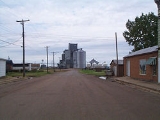
New Leipzig, North Dakota
Encyclopedia
As of the census
of 2000, there were 274 people, 131 households, and 78 families residing in the city. The population density
was 306.4 people per square mile (118.9/km²). There were 164 housing units at an average density of 183.4 per square mile (71.1/km²). The racial makeup of the city was 99.27% White and 0.73% Native American. 87.2% were of German
ancestry according to Census 2000.
There were 131 households out of which 21.4% had children under the age of 18 living with them, 55.0% were married couples
living together, 3.1% had a female householder with no husband present, and 39.7% were non-families. 39.7% of all households were made up of individuals and 27.5% had someone living alone who was 65 years of age or older. The average household size was 2.09 and the average family size was 2.76.
In the city the population was spread out with 20.1% under the age of 18, 4.4% from 18 to 24, 19.3% from 25 to 44, 24.1% from 45 to 64, and 32.1% who were 65 years of age or older. The median age was 49 years. For every 100 females there were 91.6 males. For every 100 females age 18 and over, there were 79.5 males.
The median income for a household in the city was $30,521, and the median income for a family was $35,833. Males had a median income of $32,000 versus $17,917 for females. The per capita income
for the city was $16,231. About 2.5% of families and 8.1% of the population were below the poverty line, including 9.4% of those under the age of eighteen and 13.6% of those sixty five or over.
Census
A census is the procedure of systematically acquiring and recording information about the members of a given population. It is a regularly occurring and official count of a particular population. The term is used mostly in connection with national population and housing censuses; other common...
of 2000, there were 274 people, 131 households, and 78 families residing in the city. The population density
Population density
Population density is a measurement of population per unit area or unit volume. It is frequently applied to living organisms, and particularly to humans...
was 306.4 people per square mile (118.9/km²). There were 164 housing units at an average density of 183.4 per square mile (71.1/km²). The racial makeup of the city was 99.27% White and 0.73% Native American. 87.2% were of German
Germans
The Germans are a Germanic ethnic group native to Central Europe. The English term Germans has referred to the German-speaking population of the Holy Roman Empire since the Late Middle Ages....
ancestry according to Census 2000.
There were 131 households out of which 21.4% had children under the age of 18 living with them, 55.0% were married couples
Marriage
Marriage is a social union or legal contract between people that creates kinship. It is an institution in which interpersonal relationships, usually intimate and sexual, are acknowledged in a variety of ways, depending on the culture or subculture in which it is found...
living together, 3.1% had a female householder with no husband present, and 39.7% were non-families. 39.7% of all households were made up of individuals and 27.5% had someone living alone who was 65 years of age or older. The average household size was 2.09 and the average family size was 2.76.
In the city the population was spread out with 20.1% under the age of 18, 4.4% from 18 to 24, 19.3% from 25 to 44, 24.1% from 45 to 64, and 32.1% who were 65 years of age or older. The median age was 49 years. For every 100 females there were 91.6 males. For every 100 females age 18 and over, there were 79.5 males.
The median income for a household in the city was $30,521, and the median income for a family was $35,833. Males had a median income of $32,000 versus $17,917 for females. The per capita income
Per capita income
Per capita income or income per person is a measure of mean income within an economic aggregate, such as a country or city. It is calculated by taking a measure of all sources of income in the aggregate and dividing it by the total population...
for the city was $16,231. About 2.5% of families and 8.1% of the population were below the poverty line, including 9.4% of those under the age of eighteen and 13.6% of those sixty five or over.
External links
- News from New Leipzig 1933 in six letters to David Hintz May 1933, June 1933, August 1933, November 1933, December 1933.
- City of New Leipzig official website

